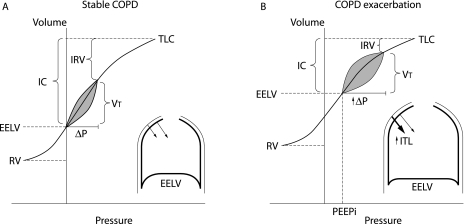Figure 3 Schematic of mechanical effects of COPD exacerbation. Representative pressure‐volume plots during (A) stable COPD and (B) COPD exacerbation. During exacerbation, worsening expiratory flow limitation results in dynamic hyperinflation with increased end expiratory lung volume (EELV) and residual volume (RV). Corresponding reductions occur in inspiratory capacity (IC) and inspiratory reserve volume (IRV). Total lung capacity (TLC) is unchanged. As a result, tidal breathing becomes shifted rightward on the pressure‐volume curve, closer to TLC. Mechanically, increased pressures must be generated to maintain tidal volume (Vt). At EELV during exacerbation, intrapulmonary pressures do not return to zero, representing the development of intrinsic positive end expiratory pressure (PEEPi) which imposes increased inspiratory threshold loading (ITL) on the inspiratory muscles (inset); during the subsequent respiratory cycle, PEEPi must first be overcome in order to generate inspiratory flow.

An official website of the United States government
Here's how you know
Official websites use .gov
A
.gov website belongs to an official
government organization in the United States.
Secure .gov websites use HTTPS
A lock (
) or https:// means you've safely
connected to the .gov website. Share sensitive
information only on official, secure websites.
